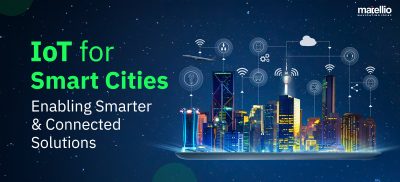
Internet of Things (IoT) has transformed many industries over the last couple of years. From helping healthcare providers offer better services to their patients to enabling businesses to make their internal and customer-facing processes more streamlined, IoT’s impact on the business and consumer worlds can’t be overstated.
But with all the amazing benefits that it has to offer to the business side of various industries, it is often very easy to overlook how much improvement it can provide to other more critical areas of our lives.
A great example of this would be the increasing role of IoT in agriculture.
Among the most ancient and vital human professions, the well-being of the agriculture industry is essential for the very survival of the human race.
At the time of writing this article, there are 7.96 billion of us on this planet! And this number is projected to reach 9.7 billion by 2050.
To support and sustain a population this massive, the UN Food and Agriculture Organization predicts that we will have to grow 70% more food in 2050 than we are right now. But unpredictable weather patterns, the constantly dwindling air quality, the loss of arable soil, and the decreasing size of farmlands due to aggressive urbanization, make growing that much food seem impossible.
However, things are not as bleak as they might seem at first glance.
Thanks to the diligent efforts of countless scientists across the globe, we are making steady strides towards smarter farming practices that provide greater crop yields. And enabling them on this conquest is the IT sector. From finding a way to replenish our drastically decreasing natural resources to developing new, more resilient variants of major staple crops, the IT sector has been the most essential ally for the agriculture sector.
Using internet connectivity and technologies such as AI, Big Data, and IoT, farmers can now keep a watch on their farms remotely, turn on various machinery, and even plan various farming processes ahead of time with the help of all the key information that is now available to them, thanks to the growing internet penetration in rural and farming communities.
IoT is gaining a lot of popularity in most industries including agriculture as the quintessential enabler of innovation and streamlined no-waste business processes. In 2021, the global agriculture IoT market was valued at $11.4 billion and this number is estimated to reach $18.1 billion by 2026 at a CAGR of 9.8%. These numbers, when coupled with the dire need we face to grow more food and fast, paint a very bright future for IoT in agriculture. And in this article, we will talk about some of the key ways in which IoT is revolutionizing the agriculture sector.
But Wait, What Even is IoT?
Internet of Things or IoT, as it is more commonly referred to, is a technology in which various internet-enabled devices, sensors, appliances, and any other electronic devices you wouldn’t expect to have the ability to connect to the internet, like a watch or an oven, are connected to one another in a wired or wireless fashion.
IoT devices share real-time data with each other and a backend server and most of these devices have enough intelligence in them that they can perform certain actions if a particular condition becomes true or false. In this way, IoT paves the way for task automation, advanced data analytics, predictive maintenance, customer behavior study, and many other such abilities that are essential for smart premises like smart offices, smart factories, smart hospitals, etc. The various devices proliferated across these spaces are constantly exchanging data with each other and the server and the manager can study, analyze, and even control these devices remotely.
How Does IoT Work?
Let’s try to understand what we just learned with an example of IoT in agriculture. Imagine that a farmer wants to keep a better eye on his livestock and wants to use IoT to do so. He wants to be able to track all the animals and monitor their health conditions to prevent any outbreaks. At the same time, he would also like to keep his sheds temperature-controlled and keep the trespassers out.
To track the cattle, the farmer needs to put tracking implants on each animal on his farm. These trackers send small geolocation data packets called pings on a regular time interval making it possible for the farmer to get the real-time location of his livestock. Furthermore, IoT also makes geofencing possible for the farmer. Whenever an animal walks out of a marked area on the property, the farmer is notified. This way, cattle can be better prevented from getting lost and hurting themselves.
Cattle health can be monitored with the help of various sensors that collect data and send it to an IoT application. Based on the collected data, the AI in IoT application deduces whether an animal is suffering from a disease or not. A proper record of every animal on the farm can also be kept where information like what shots that animal has received, age, etc., can be maintained.
Motion sensors on the farm perimeter can help you keep the trespassers off your property. And temperature sensors in the sheds and a smart temperature control system can help the farmer keep the atmosphere inside the sheds optimal. This is particularly helpful for cattle that are pregnant.
Every IoT implementation has two key parts: hardware and software. IoT hardware consists of various sensors and other such devices and they are selected by the users based on the type of data they collect. For instance, if you want to monitor the pressure inside a tank, then you will need a pressure sensor. Similarly, if you want to know the moisture levels in the soil, you will need to buy a different sensor.
IoT software allows users to monitor and control their IoT devices. These software apps can be cloud-based or they can be hosted locally. Based on the requirements, the sophistication level of these apps can vary drastically. For instance, if data visualization is your only need, then a vanilla software app without much depth should serve you just fine. But if you want advanced features such as smart data analytics, trend detection, business planning, etc., then you will need to integrate other technologies such as AI and Big Data with IoT.
Top Ways in Which IoT is Revolutionizing The Agriculture Sector
Now that we know the basics of IoT, it’s time to learn more about the ways in which it is changing the agriculture industry.
1. Precision Farming
Precision farming is an implementation of IoT in agriculture sector in which the goal is to optimize the farming process to minimize resource wastage and maximize crop yield and quality. In precision farming, IoT is used to make sure that resources are used optimally with the help of smart farming practices such as livestock tracking and monitoring, geofencing, farm monitoring, farm process automation, inventory management, etc. These applications require the deployment of various IoT devices and sensors. The data collected by them is used by a well-built software app that allows the farmer to make more informed decisions.
For instance, precision farming can help farmers in figuring out the right time to irrigate different crops. It can also help them keep an eye on climate conditions and even manage insecticide and pesticide spraying remotely.
Precision farming enables farmers to become more efficient, grow more food without wasting resources, and increase the quality of their crops.
2. Smart Greenhouses
Greenhouse management is one of the most time-consuming and demanding tasks on any farm. It requires farmers to be constantly vigilant of the incredibly precarious balance of various environmental factors inside the greenhouse that are crucial for good crop yield. Furthermore, a lot of manpower and energy is required to maintain a greenhouse efficiently. But with IoT, greenhouses can become smart and by extension, easier to manage and less costly to maintain.
By installing various sensors for temperature, pressure, humidity, and other such parameters, farmers can monitor the climate conditions in their greenhouses in real-time. Automated sprinklers, smart irrigation mechanisms, and climate control devices can further make greenhouse management easier. IoT makes it possible for farmers to make greenhouses completely independent of human intervention. And by doing that, they can run their greenhouses error-free and more cost-efficiently.
3. Farming Drones
Ground and aerial drones are relatively new entries in the smart farming IoT ecosystem but they are quickly becoming some of the most useful tools in any farmer’s toolbox. These drones are fitted with various sensors and can help farmers monitor their property and crops more efficiently and thoroughly. These drones are also used to spray various medicines on farms. With the help of thermal imaging, these drones can tell the farmer which areas need to be irrigated better and which are getting over-irrigated. Crop quality and health can be monitored with the help of these drones. And based on the data, farmers can even calculate vegetation index. Farming drones are also more environmentally friendly since they don’t consume as much energy. They are also very precise when it comes to operations such as insecticide and pesticide spraying. Data shows that there is a drastic decrease in harmful chemical composition in the soil on the farms that use drones instead of manual spraying.
4. Climate Monitoring
Unpredictable weather and unfavorable climate conditions are the reason why so much food is lost every year around the globe. While meteorology has come a long way and we can now predict weather way more accurately, there is still a lot of work to be done. Farmers are using climate monitoring gear of their own to ensure that they plant the right crop for the weather conditions. IoT-based climate monitoring devices allow farmers to get a more clear picture of the weather conditions surrounding their farms. This in turn helps them make more informed decisions and adopt farming practices that are favorable for a particular climate.
5. Predictive Analytics
All the data that is collected by the various IoT agriculture devices is utilized by software applications to help the farmer improve his understanding of what’s going on on his farm. IoT on its own is a very powerful technology. But when coupled with other technologies such as AI and Big Data, it becomes even more powerful. Trend detection and predictive analysis can truly improve how a farm is run and the quality of the crops. For instance, real-time climate data can be studied by AI to detect patterns and predict what the weather will be like in the future. Crop quality and crop yield can also be predicted with advanced AI engines. Predictive analysis also makes it possible for the farmers to prevent infrastructure breakdowns. IoT sensors let farmers monitor the health of their various devices and vehicles. Based on certain parameters, AI can predict if a device is going to break down. Farmers can take proactive measures and get the device fixed before it shuts down, thus preventing a substantial dip in productivity.
Also Read- IoT Software Development: A Complete Guide
Conclusion
IoT is going to play a big role in shaping the future of agriculture. From IoT applications helping farmers make more informed decisions to modern farming practices enabled by sophisticated IoT infrastructure, there are many ways IoT implementation is beneficial for the agriculture sector. And if you are looking to step into the future and modernize your farm, then Matellio is the right partner for you. As an experienced IoT partner, we offer IoT consultation and development services for farms of all sizes. Our IoT experts are industry veterans and know how to help you maximize your crop yields while cutting back on resource wastage. We have helped countless clients across the globe in their IoT implementation projects with the help of our scalable IoT development and consultation services.
If you want to learn more about Matellio’s IoT development services, click here.





